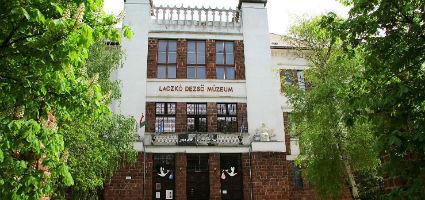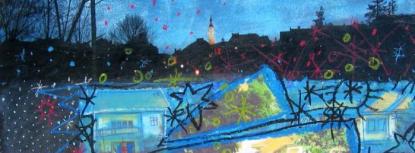2024. May 3. Friday
Dezső Laczkó Museum - Veszprém
 |
Address: 8200, Veszprém Török Ignác u. 7.
Phone number: (88) 789-791
E-mail: titkar@ldm.hu
Opening hours: Thu-Sat 10-18
|
The exhibition has closed for visitors.
2015.06.20. - 2015.08.09.
The art of Ágnes Kulcsár can be characterised by nature experience, plant motifs, microcosm, different dimensions, dreams, memories, feelings so that it is not surprising that the topic presented here is close to her. Her collages, paintings, globes, platters, which are attached to this fabulous night of the year, portray light and shadow, light and darkness at the same time.

In addition, reality and dream are linked since photos of Buhim-valley and Veszprém were taken from her own garden, which she uses as bases to add various different formations, stylized floral motifs as well as various characters from Shakespeare's Midsummer Night's Dream, using different techniques in - we can say with style. Characters from the comedy come to life as the artist sees, imagines them. One of them is Puck, who says the following of himself: "I'm a wanderer of the night sky" but we can also find the fairy queen Titania and Bottom the weaver as well.
The pictures certainly can relate to Veszprém, in the sense that using photos taken from the banks of Séd bank, we get to the end where the fairy tale world is t e found, with magic, off course. In addition to the city, illuminated figure of the Fire Tower, the red stone details of the museum building in, the house that is the home to many, stars, the moon, plants, flowers, cartoon characters crop up in the night. In fact, these works are not bound to any location, though the title suggests this, we can rather talk about some kind of internal happening.
To show the night is not an easy task, but Ági Kulcsár solved this extraordinary task. Even the dark-toned images let serenity joy and a sense of obedience let filter through. The titles also suggest the atmosphere of the world to which she is guiding us. The wizard's garden - with the misty, mysterious forest with which the frame is a part of the image indicate that there are no limits, no barriers; Bottom's dream - which was inspired by the comedy, at the same time reminds us of Apuleius Golden Ass. The narrative and allegorical elements recall Chagall's surrealist tale illustrations and his paintings Midsummer Night's Dream from 1939. The feeling of love and longing appears in the collage 'Happiness dream' with its airy female form.
In addition to the sense of dreams and boundlessness, the sense of completeness is present, too. The globes, the Orion and Galaxy do not only suggest Earth as a whole, but the universe beyond. This disk 'Round World' on wheels with its shades of green and blue show the connection of the sky and the Earth. Its two sides were built to emphasize contrast.
It is interesting to consider that Ágnes Kulcsár's paintings reality is given - through the photo used - but with a randomly selected, paused a moment, and then this captured moment turns into another realm by the artist combining a variety of techniques and using photos as raw material to create the images. The end results are not the photo being a self-dominant media any longer, but it becomes part of the whole. Thus, the viewer does not want to see the reality, but the underlying content or intrinsic motivation comes to the fore. It may be considered a special visual alphabet.
The art historian, museologist Szonja Dohnál

In addition, reality and dream are linked since photos of Buhim-valley and Veszprém were taken from her own garden, which she uses as bases to add various different formations, stylized floral motifs as well as various characters from Shakespeare's Midsummer Night's Dream, using different techniques in - we can say with style. Characters from the comedy come to life as the artist sees, imagines them. One of them is Puck, who says the following of himself: "I'm a wanderer of the night sky" but we can also find the fairy queen Titania and Bottom the weaver as well.
The pictures certainly can relate to Veszprém, in the sense that using photos taken from the banks of Séd bank, we get to the end where the fairy tale world is t e found, with magic, off course. In addition to the city, illuminated figure of the Fire Tower, the red stone details of the museum building in, the house that is the home to many, stars, the moon, plants, flowers, cartoon characters crop up in the night. In fact, these works are not bound to any location, though the title suggests this, we can rather talk about some kind of internal happening.
To show the night is not an easy task, but Ági Kulcsár solved this extraordinary task. Even the dark-toned images let serenity joy and a sense of obedience let filter through. The titles also suggest the atmosphere of the world to which she is guiding us. The wizard's garden - with the misty, mysterious forest with which the frame is a part of the image indicate that there are no limits, no barriers; Bottom's dream - which was inspired by the comedy, at the same time reminds us of Apuleius Golden Ass. The narrative and allegorical elements recall Chagall's surrealist tale illustrations and his paintings Midsummer Night's Dream from 1939. The feeling of love and longing appears in the collage 'Happiness dream' with its airy female form.
In addition to the sense of dreams and boundlessness, the sense of completeness is present, too. The globes, the Orion and Galaxy do not only suggest Earth as a whole, but the universe beyond. This disk 'Round World' on wheels with its shades of green and blue show the connection of the sky and the Earth. Its two sides were built to emphasize contrast.
It is interesting to consider that Ágnes Kulcsár's paintings reality is given - through the photo used - but with a randomly selected, paused a moment, and then this captured moment turns into another realm by the artist combining a variety of techniques and using photos as raw material to create the images. The end results are not the photo being a self-dominant media any longer, but it becomes part of the whole. Thus, the viewer does not want to see the reality, but the underlying content or intrinsic motivation comes to the fore. It may be considered a special visual alphabet.
The art historian, museologist Szonja Dohnál
